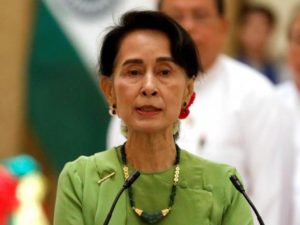Behind the Rohingya crisis
The world’s most recent humanitarian crisis – the flight of the Rohingya people from Myanmar – has its roots in decades of sectarian mistrust fanned by a ruthless military dictatorship.
Since the 1970s Muslim Rohingya have been have been targeted in a cycle of violence by Buddhists and Myanmar security forces, prompting the UN to describe them as among the world’s most persecuted people.
This has fostered a rising insurgency among some Rohingya who have been aided by hardened Muslim extremists from other parts of the world.
The most recent crisis can be tracked back to August last year when militants attacked police stations in wester Myanmar – the very day the UN released a report into previous bloodshed.
Think tank the International Crisis Group says a group of Rohingya emigres with experience in guerrilla warfare oversees the militants from Saudi Arabia.
The group’s leader Attaullah Abu Ammar Jununi was born in Pakistan and raised in Saudi Arabia. Muslim militants started to secretly train in guerrilla warfare after ethnic riots in 2012 killed hundreds of Rohingya.

Aung San Suu Kyi
The militants are now fighting against Myanmar security forces in the Rakhine state.
Rohingyas were stripped of their citizenship in 1982 as part of decades-long persecution that has denied them basic rights, including freedom of movement.
In 2012, they were the target of violent Buddhist mobs that forced more than 140,000 from their homes into squalid camps.
In March 2014, the Myanmar government banned the word Rohingya and asked for registration of the minority as Bengalis in the country’s first census in three decades.
This meant that 1.3 million Rohingya in Arakan, also called Rakhine state, were not included in the census.
In April 2015, the government formally rescinded the temporary ID or “white cards”, the last form of official government identification for Rohingya, stripping them of voting rights linked to the cards.
The Rohingya had hoped the election of Nobel Peace laureate and democracy champion Aung San Suu Kyi in November 2015 would see a turnaround in hostility towards them from the new government in Naypyidaw and Buddhist groups.
But violence against them – largely perpetrated by the Myanmar military – has dramatically increased since then.
A UN report in February this year accused Myanmar security forces of atrocities against the Rohingya that could amount to crimes against humanity.
Observers say that unless Myanmar’s security forces end their brutality in Rakhine and the government of Aung San Suu Kyi adopts a political response to the crisis, increasing numbers of Rohingya are likely to swing their support to the militants.
Although the country’s de facto leader, Suu Kyi is caught between politically by the powerful Myanmar military, nationalist Buddhist-majority parties and an undemocratic Constitution.
She says her government, swept into power at historic elections in 2015, cannot tell the military not to launch offensives.
Army generals see themselves as saviours of the country. Many Buddhists hate Rohingya and label them “Bengali” illegal immigrants and if Suu Kyi spoke up for the Rohingya she would alienate her support base.
Perhaps more worrying is that the crisis is dividing Buddhists and Muslims across south-east and South Asia. Anti-Buddhist protests have already been held across Pakistan, India and Indonesia.
Equally worrying is the possibility the plight of the Rohingya could become a spark for underlying divisions and tensions between Muslims and non-Muslims in countries including Indonesia, Malaysia and India, where hundreds of thousands of Rohingya are living.
Laurie Nowell
AMES Australia Senior Journalist












